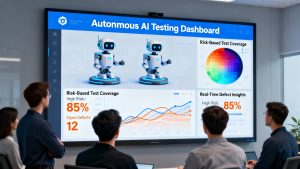In today’s software-driven, always-on economy, product quality isn’t a luxury—it’s a baseline expectation. Whether it’s a consumer-facing app, a mission-critical enterprise system, or government-led digital initiatives like UPI or DigiLocker, users demand fast, secure, and flawless software experiences. In this landscape, Quality Assurance (QA) engineers are no longer viewed as just bug-finders—they are gatekeepers of product excellence and advocates for the end-user experience.
In India, the need for QA professionals has grown dramatically with the expansion of the IT services industry, startup ecosystems, and digital transformation across sectors like finance, healthcare, logistics, and e-commerce. QA engineers are now embedded in cross-functional teams, working alongside developers, product managers, and DevOps engineers to shift testing left—bringing quality into focus right from the requirements stage.
Unlike the traditional perception of QA as a “post-development checkpoint,” modern QA engineers participate in everything from test planning and design, to automated test development, to performance benchmarking, and even release management. They are skilled in scripting, tool integration, and increasingly, automation-first strategies that keep up with agile and DevOps cycles.
But what does a career path look like for a QA engineer in India? How does one grow from executing manual test cases to leading quality strategy across complex, distributed systems?
In this blog, we break down the evolution of a QA career in India—from junior-level roles to senior leadership positions.
Whether you’re an aspiring tester, a mid-level QA looking to grow, or a team lead building a QA function, this guide will help you understand the roadmap, expectations,and practices that define success in the Indian QA landscape.
What Does a QA Engineer Do?
A QA engineer is responsible for maintaining the software’s quality and ensuring that bugs don’t reach production. Their tasks may include:
- Understanding business requirements and translating them into test cases
- Executing manual or automated test cases
- Identifying, logging, and tracking bugs
- Collaborating with developers, product managers, and DevOps teams
- Ensuring test coverage for edge cases, performance, and security
- Building test frameworks and integrating them into CI/CD pipelines
Career Stages of a QA Engineer
1. Junior QA Engineer (0–2 years)
Responsibilities:
- Understanding requirements from user stories or documentation
- Writing and executing manual test cases
- Reporting issues using tools like JIRA or Bugzilla
- Learning QA fundamentals like smoke, regression, and exploratory testing
Tools & Skills:
- Basics of HTML, HTTP methods, and client-server architecture
- Test case management tools (TestRail, Zephyr)
- Understanding of SDLC and STLC
Sample Manual Test Case:
vbnet
Test Case ID: TC001
Title: Login Functionality
Preconditions: User has a valid username and password
Steps:
1. Navigate to login page
2. Enter valid credentials
3. Click login button
Expected Result:
User is redirected to the dashboard
2. QA Engineer (2–4 years)
Responsibilities:
- Writing automated test cases
- Testing APIs, integrations, and database workflows
- Performing regression and cross-browser testing
- Participating in sprint planning and contributing to QA strategy
Skills:
- Scripting in Java, Python, or JavaScript
- Tools like Selenium WebDriver, Postman, or RestAssured
- Knowledge of CI/CD pipelines (GitHub Actions, Jenkins)
Code Example: Selenium Test in Java
java
import org.openqa.selenium.WebDriver;
import org.openqa.selenium.chrome.ChromeDriver;
import org.openqa.selenium.By;
public class LoginTest {
public static void main(String[] args) {
WebDriver driver = new ChromeDriver();
driver.get("https://example.com/login");
driver.findElement(By.id("username")).sendKeys("testuser");
driver.findElement(By.id("password")).sendKeys("password123");
driver.findElement(By.id("login")).click();
String title = driver.getTitle();
System.out.println("Page title: " + title);
driver.quit();
}
}3. Senior QA Engineer (4–7 years)
Responsibilities:
- Building and maintaining automation frameworks
- Performing load testing, security testing, and data validation
- Guiding junior QAs and reviewing test strategies
- Aligning QA efforts with product goals and user needs
Tools & Skills:
- Frameworks: JUnit, TestNG, Pytest
- Tools: JMeter, Cypress, Selenium Grid
- Scripting proficiency and a DevOps mindset
Code Example: Cypress (JavaScript)
javascript
describe('Login Test', () => {
it('Logs in with valid credentials', () => {
cy.visit('https://example.com/login');
cy.get('#username').type('testuser');
cy.get('#password').type('password123');
cy.get('#login').click();
cy.url().should('include', '/dashboard');
});
});4. QA Lead / Automation Architect (7+ years)
Responsibilities:
- Defining QA policies, governance, and best practices
- Leading automation strategy across multiple projects
- Collaborating on product architecture and release cycles
- Driving test coverage analytics and QA dashboards
Skills:
- Strong understanding of DevOps, Agile, and Scrum
- Test frameworks and libraries (e.g., Cucumber, Robot Framework)
- Hands-on with infrastructure (Docker, Kubernetes, cloud platforms)
Example: GitHub Actions for Test Automation
yaml
name: Run Automated Tests
on: [push]
jobs:
test:
runs-on: ubuntu-latest
steps:
- name: Checkout code
uses: actions/checkout@v2
- name: Setup Node.js
uses: actions/setup-node@v2
with:
node-version: '16'
- name: Install dependencies
run: npm install
- name: Run Cypress Tests
run: npm run test
Emerging Trends in QA Careers in India
- AI-Driven Testing: Tools like Testim and Mabl use AI to auto-generate and maintain test scripts.
- Testing as Code (TaC): Emphasizing code-driven tests integrated with development pipelines.
- Cloud & Mobile Testing: Tools like BrowserStack and LambdaTest are gaining prominence in India’s mobile-first market.
- Security & Compliance: QA engineers are expected to validate GDPR, HIPAA, and PCI DSS adherence.
Certifications and Courses That Help
- ISTQB Foundation/Advanced
- Certified Selenium Tester
- Agile Tester Extension
- AWS Certified DevOps Engineer
- Postman API Fundamentals
Popular platforms: Coursera, edX, Udemy, Pluralsight
How to Grow as a QA Engineer in India
- Master Automation: Don’t rely solely on manual testing. Learn tools like Playwright, Cypress, and Appium.
- Understand DevOps: Learn CI/CD tools and containerization.
- Build Soft Skills: Communicate clearly, mentor juniors, and engage in product discussions.
- Work on Real Projects: Contribute to open-source or freelance QA work to gain diverse exposure.
Conclusion
The QA career path in India is no longer a siloed, repetitive task role—it’s a gateway into engineering excellence. From writing your first manual test case to building AI-powered test frameworks and influencing release decisions, the journey is packed with opportunities to grow technically and strategically.
Whether you’re just entering the field or aiming for a lead role, remember: testing isn’t just about finding bugs—it’s about enabling teams to deliver the best possible product with confidence.
By continually learning, automating, and aligning with business goals, Indian QA professionals can become the backbone of global-quality software development.



